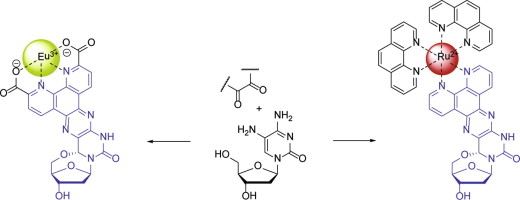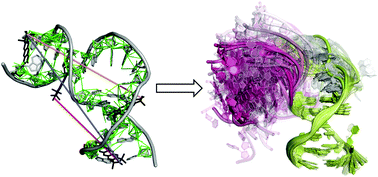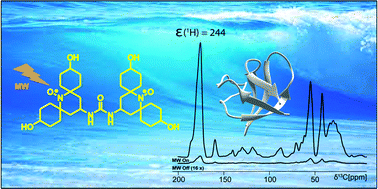Nucleic acid chemistry
 Interest in nucleic acids and their functions drives the research in our laboratory. We mainly use the tools of organic chemistry to make various probes that we incorporate into both DNA and RNA. In recent years we have focused on nitroxides, which are stable radicals that are useful spin labels for electron paramagnetic resonance (EPR) spectroscopy. We have also made fluorescent nucleosides and metal-ion complexes for incorporation into nucleic acids. Some examples are shown on the right. More information can be obtained on the Publications page.
Interest in nucleic acids and their functions drives the research in our laboratory. We mainly use the tools of organic chemistry to make various probes that we incorporate into both DNA and RNA. In recent years we have focused on nitroxides, which are stable radicals that are useful spin labels for electron paramagnetic resonance (EPR) spectroscopy. We have also made fluorescent nucleosides and metal-ion complexes for incorporation into nucleic acids. Some examples are shown on the right. More information can be obtained on the Publications page.Biophysical studies - structural biology
 Another aspect of our research is to utilize the spectroscopic probes prepared in our laboratory for the study of the structure and dynamics of nucleic acids. For example, we have used electron paramagnetc resonance (EPR) spectroscopy to map the changes in dynamics of the bulge in the TAR RNA, involved in the life-cycle of the HIV virus. This data has enabled us determine what ligands, such as various metal ions and small organic ligands are able to induce formation similar RNA structures upon binding. More recently, we have also investigted the dynamics of nucleic acids in collaboration with the Prisner group at the University of Frankfurt. For example, a combination of the rigid spin label Ç and pulsed EPR spectroscopy yielded restraints of distance and orientation that was used along with high-resolution NMR data to get an atomistic view of the dynamics of a two-way DNA junction(see the picture on the right).
Another aspect of our research is to utilize the spectroscopic probes prepared in our laboratory for the study of the structure and dynamics of nucleic acids. For example, we have used electron paramagnetc resonance (EPR) spectroscopy to map the changes in dynamics of the bulge in the TAR RNA, involved in the life-cycle of the HIV virus. This data has enabled us determine what ligands, such as various metal ions and small organic ligands are able to induce formation similar RNA structures upon binding. More recently, we have also investigted the dynamics of nucleic acids in collaboration with the Prisner group at the University of Frankfurt. For example, a combination of the rigid spin label Ç and pulsed EPR spectroscopy yielded restraints of distance and orientation that was used along with high-resolution NMR data to get an atomistic view of the dynamics of a two-way DNA junction(see the picture on the right).Dynamic Nuclear Polarization
 NMR spectroscopy is an extremely valuable technique to obtain high-resolution structural information for many different types of molecules and materials, as well as information about dynamics on different time-scales. However, NMR is an inherently insensitive method, which restricts its scope. In the last few years, dynamic nuclear polarization (DNP) has emerged as a powerful technique to increase the sensitivity of NMR by orders of magnitude through the transfer of polarization from unpaired electrons to nuclei. We have contributed to this new and exciting field by making biradical polarizing-agents. We have prepared radicals that combine two features: give a high DNP enhancement (over 200-fold for protons) and water solubility, which enables these biradicals to be used to study the structure and dynamics of biopolymers.
NMR spectroscopy is an extremely valuable technique to obtain high-resolution structural information for many different types of molecules and materials, as well as information about dynamics on different time-scales. However, NMR is an inherently insensitive method, which restricts its scope. In the last few years, dynamic nuclear polarization (DNP) has emerged as a powerful technique to increase the sensitivity of NMR by orders of magnitude through the transfer of polarization from unpaired electrons to nuclei. We have contributed to this new and exciting field by making biradical polarizing-agents. We have prepared radicals that combine two features: give a high DNP enhancement (over 200-fold for protons) and water solubility, which enables these biradicals to be used to study the structure and dynamics of biopolymers.